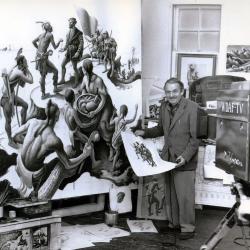Thomas Hart Benton
Often considered among the most popular 20th-century American artists, Thomas Hart Benton was one of the leading Regionalists, a loosely associated group of realist painters who became best known for depicting rural American subjects, beginning during the Depression. In the 1920s and 1930s Benton consciously rejected abstraction in favor of a naturalistic approach expressed in undulating, rhythmic forms, and he developed a narrative style that focused on American social history. Although often associated with his native Midwest, Benton spent some two decades working and teaching in New York City.
In 1956 Benton was commissioned by Robert Moses, chairman of the New York Power Authority, to create two murals for the powerhouse building of the state’s first hydropower facility in Massena. They feature Jacques Cartier’s explorations of the St. Lawrence River and the Gulf of St. Lawrence. Alternately titled The Seneca Discover the French and Jacques Cartier Discovers the Indians, the murals depict the 16th-century encounters from two points of view. Benton took liberties with the timing of two actual events in his representation, however, combining them into a single scene for, he noted, “the sake of historical meaning.” In spite of this inaccuracy, Benton had thoroughly researched the subject, studying Cartier’s accounts and working with prints made shortly thereafter, as well as a model of the ship. In addition, Benton noted, the “Indian costumes, war clubs, headdresses etc. are for the most part based upon exhibits of Iriquois [sic] life in the State Museum at Albany, N.Y.” These life groups were on view at the Museum when it was housed at the State Education Building. The original building in Massena where these murals were displayed is now closed to the public. They were removed and conserved beginning in 2018 and are on loan to the New York State Museum.
Karen Quinn
Senior Historian/Curator, Art and Culture, New York State Museum
The Murals
In 1956 the Power Authority of the State of New York (NYPA) commissioned two paintings by Thomas Hart Benton (1889–1975) for display at the Robert Moses Power Dam in Massena, New York. Both panels celebrate French explorer Jacques Cartier’s 1534–1535 voyage into the Gulf of St. Lawrence to Lachine Rapids, just south of present-day Montreal. In these paintings, Benton portrays imagined scenes, drawn from details Cartier captured in accounts of his expedition.
The first panel depicts the local Iroquoian people running to investigate the strangers’ ship anchored near their palisaded village. Benton did considerable research for his murals, visiting historic sites, reading archival sources, and examining related artifacts in museum collections. The village portrayed is based on a 16th-century illustration of Cartier’s observations. Benton was careful to depict the Iroquoian people as skilled agriculturists, tending their crops of corn, beans, and squash. He found models for his subjects among the Seneca and Cayuga peoples living in Oklahoma (closer to Benton’s home in Missouri), and he based their weapons and headdresses on artifacts he had seen at the New York State Museum.
The second panel portrays Cartier presenting a wary elder with a cross, while French soldiers erect a much larger cross in the background. Benton wished to honor both the Indigenous peoples and the explorers in these paintings, depicting a fertile and inhabited land about to be changed forever.
Scott Manning Stevens, PhD
Director, Native American and Indigenous Studies, Syracuse University
Gallery View
Benton based his rendering of the village in the mural on this 16th-century image. This map is said to be the first printed depiction of an intact indigenous town in North America, and what would become Montreal. Note the protective wooden palisade surrounding a settlement of orderly streets and square buildings and homes, arranged around a central square, in an orthogonal, or grid, pattern. Credit: Wikimedia Commons
Thomas Hart Benton referred to the State Museum’s Iroquois Indian Groups exhibition when creating the Massena murals. The diorama shown here was titled “The Mohawk Warrior Group.” It was one of six such groups on display at the Museum when it opened in 1916 at the New York State Education Building. In 1975 the exhibition closed, and the life figures, painted backgrounds, clothing, and artifacts were placed in long-term storage.



